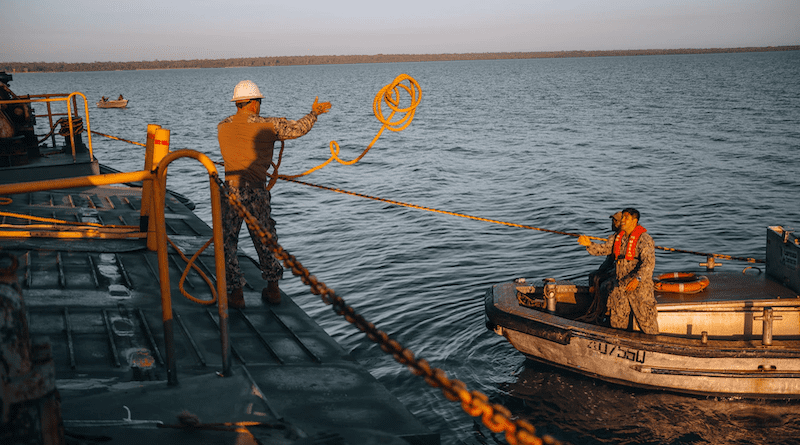US Forces Validate Ship-To-Shore Logistics Capability At Talisman Sabre 23
By DoD News
By Joseph Clark
Units participating in this year’s large-scale military exercise with Australia have demonstrated a key logistical capability critical for enabling U.S. and partner forces to maintain a free and open Indo-Pacific.
Hours after Talisman Sabre 23 kicked off in Sydney last week, more than 200 soldiers and sailors were putting the finishing touches on a three-mile-long fuel and water pipeline in Weipa, a remote mining town on Australia’s Cape York Peninsula.
The pipeline was pieced together using 19-foot tubes plucked from prepositioned stores staged throughout the theater. It was assembled as part of a joint petroleum over-the-shore operation designed to simulate the transfer of fuel pumped from an offshore vessel to inland distribution points used for operations in a resource-constrained environment.
On Saturday, sailors from Amphibious Construction Battalion 1 and active and reserve soldiers assigned to the Eighth Army, 475th Quartermaster Group and the 555th and 130th Engineer Brigade successfully connected the onshore pipeline to 175,000-gallon tanks aboard Australian commercial landing craft about 1,000 meters offshore.
While Army logisticians train similar fuel transfer techniques in controlled environments, the opportunity to train in an environment that reflects real world operational challenges will pay dividends, said Army Capt. Clovis Vaughn, the operations officer with the 475th Quartermaster Group.
“Seeing this happen for real makes us … a lot more confident that, if we have to go do this again for real somewhere in an environment very similar to this, we’re ready to go,” he said. “This has been a huge opportunity to really put in practice what we thought we could do and really validate those things.”
In addition to sustaining combat-ready forces in areas lacking permanent fuel infrastructure, the over-the-shore concept can also be used to shuttle fresh water to distribution points during humanitarian assistance operations.
The capability is particularly crucial for overcoming the unique logistical challenges posed by the Indo-Pacific. More than one-third of the countries in the U.S. Indo-Pacific Command’s area of responsibility are small island nations separated by broad swaths of ocean.
The JPOTS operation reflects the key aims of Talisman Sabre, a biennial exercise designed to advance a free and open Indo-Pacific by strengthening partnerships and interoperability among key allies. The spelling of the name — sabre vs. saber — reflects which country is leading the exercise: Talisman Sabre when Australia leads and Talisman Saber when the U.S. leads.
Army Capt. Glenn Peebles, a petroleum platoon commander with Australia’s 9th Force Support Battalion who observed the JPOTS operation, said the exercise provided valuable insight as his unit prepares to field new fuel-delivery capabilities.
“There’s so much we can learn off each other,” he said. “And there’s a high likelihood that we will work together in different theaters in the coming years, so to consistently do it each year means that we’ll be ready to do it when we need to do it for real.”
Army Col. Margaret McGunegle, commander of the 130th Engineer Brigade, said the bonds formed at the soldier level through exercises like Talisman Sabre are key to U.S. success in the region.
“That’s what builds partnerships,” she said. “It’s people that have worked together, walked the same path, done exercises together for years and years. Those personal relationships, a lot of the times, are the ones that then can make some of these more strategic relationships work because they understand each other.”

